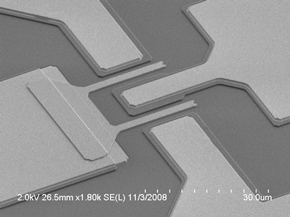
| Home | About Us | Contribute | Bookstore | Advertising | Subscribe for Free NOW! |
| News Archive | Features | Events | Recruitment | Directory |
| FREE subscription |
| Subscribe for free to receive each issue of Semiconductor Today magazine and weekly news brief. |
News
5 December 2008
HRL demos first RF graphene FETs
HRL Laboratories LLC of Malibu, CA, USA says that it has demonstrated the first RF graphene field-effect transistors (FETs), the first milestone in the proposed 51-month, three-phase program ‘Carbon Electronics for RF Applications’ (CERA) to develop a new generation of carbon-based RF integrated circuits for ultra-high-speed, ultra-low-power applications.

Picture: HRL Laboratories' RF graphene field-effect transistor.
HRL is collaborating with a group of universities, commercial companies and the Naval Research Laboratory (NRL) on the program, which is sponsored by the Defense Advanced Research Projects Agency (DARPA) and under the management of the Space and Naval Warfare Systems Center (SPAWAR). CERA’s goal is to exploit the unique qualities of graphene carbon to create components that will enable unprecedented capabilities in high-bandwidth communications, imaging, and radar systems.
The military’s ability to develop sophisticated imaging and communications systems is hindered by RF component cost, limited resolution, and high power dissipation, says HRL. A graphene-on-silicon platform could revolutionize military applications because of its high performance, scalability, integration and low cost, the firm adds.
Graphene is a single layer of carbon atoms densely packed in a honeycomb crystalline lattice configuration. The advantages are its high current-carrying capacity, excellent thermal conductivity and low-voltage operational potential.
While graphene FETs have been demonstrated before, most used exfoliated graphene films. “HRL, working with the NRL, demonstrated graphene FETs using epitaxial film operating in the RF frequency range,” says Jeong-sun Moon, senior research scientist in HRL’s Microelectronics Laboratory. “This is a key step toward wafer-scale high-speed graphene RF FETs that operate in the RF domain,” he adds.
The FETs’ on-state current was 1180μA/μm at a drain bias of 1V. RF performance was characterized using an HP8510, yielding an extrinsic current gain cut-off frequency (fT) of 4GHz with a gate length of 2μm. A record maximum oscillation frequency (fmax) of 14GHz was achieved at Vds = 5V. The RF speed performance is expected to be improved as the graphene FETs are scaled to sub-100nm gate lengths with reduced parasitic capacitance and resistance.
“The next step will be to continue to optimize material synthesis and device processing to see if we can harness the unique properties of graphene to make a new-generation, state-of-the-art technology for future high-speed, low-cost military RF systems-on-chips,” Moon says.
In upcoming phases of the project, the HRL team will fabricate FETs on 100mm-diameter wafers and then scale up the process to 200mm wafers to create a demonstration prototype of the new generation of carbon-based RFICs.
See related item:
IQE works with CERA program to develop graphene carbon-based RF technology
Visit: www.hrl.com
Visit: www.darpa.mil/MTO/programs/cera